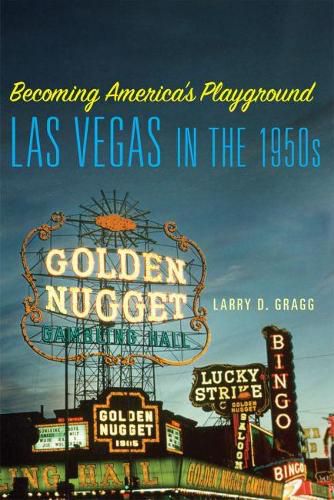Readings Newsletter
Become a Readings Member to make your shopping experience even easier.
Sign in or sign up for free!
You’re not far away from qualifying for FREE standard shipping within Australia
You’ve qualified for FREE standard shipping within Australia
The cart is loading…






In 1950 Las Vegas saw a million tourists. In 1960 it attracted ten million. The city entered the fifties as a regional destination where prosperous postwar Americans could enjoy vices largely forbidden elsewhere, and it emerged in the sixties as a national hotspot, the glitzy resort city that lights up the American West today. Becoming America’s Playground chronicles the vice and the toil that gave Las Vegas its worldwide reputation in those transformative years.
Las Vegas’s rise was no happy accident. After World War II, vacationing Americans traveled the country in record numbers, making tourism a top industry in such states as California and Florida. The Las Vegas Chamber of Commerce saw its chance and developed a plan to capitalize on the town’s burgeoning reputation for leisure. Las Vegas pinned its hopes for the future on Americans’ need for escape.
Transforming a vice city financed largely by the mob into a family vacation spot was not easy. Hotel and casino publicists closely monitored media representations of the city and took every opportunity to stage images of good, clean fun for the public - posing even the atomic bomb tests conducted just miles away as an attraction.
The racism and sexism common in the rest of the nation in the era prevailed in Las Vegas too. The wild success of Frank Sinatra’s Rat Pack performances at the Sands Hotel in 1960 demonstrated the city’s slow progress toward equality. Women couldn’t work as dealers in Las Vegas until the 1970s, yet they found more opportunities for well-paying jobs there than many American women could find elsewhere.
Gragg shows how a place like the Las Vegas Strip - with its glitz and vast wealth and its wildly public consumption of vice - rose to prominence in the 1950s, a decade of Cold War anxiety and civil rights conflict. Becoming America’s Playground brings this pivotal decade in Las Vegas into sharp focus for the first time.
$9.00 standard shipping within Australia
FREE standard shipping within Australia for orders over $100.00
Express & International shipping calculated at checkout
In 1950 Las Vegas saw a million tourists. In 1960 it attracted ten million. The city entered the fifties as a regional destination where prosperous postwar Americans could enjoy vices largely forbidden elsewhere, and it emerged in the sixties as a national hotspot, the glitzy resort city that lights up the American West today. Becoming America’s Playground chronicles the vice and the toil that gave Las Vegas its worldwide reputation in those transformative years.
Las Vegas’s rise was no happy accident. After World War II, vacationing Americans traveled the country in record numbers, making tourism a top industry in such states as California and Florida. The Las Vegas Chamber of Commerce saw its chance and developed a plan to capitalize on the town’s burgeoning reputation for leisure. Las Vegas pinned its hopes for the future on Americans’ need for escape.
Transforming a vice city financed largely by the mob into a family vacation spot was not easy. Hotel and casino publicists closely monitored media representations of the city and took every opportunity to stage images of good, clean fun for the public - posing even the atomic bomb tests conducted just miles away as an attraction.
The racism and sexism common in the rest of the nation in the era prevailed in Las Vegas too. The wild success of Frank Sinatra’s Rat Pack performances at the Sands Hotel in 1960 demonstrated the city’s slow progress toward equality. Women couldn’t work as dealers in Las Vegas until the 1970s, yet they found more opportunities for well-paying jobs there than many American women could find elsewhere.
Gragg shows how a place like the Las Vegas Strip - with its glitz and vast wealth and its wildly public consumption of vice - rose to prominence in the 1950s, a decade of Cold War anxiety and civil rights conflict. Becoming America’s Playground brings this pivotal decade in Las Vegas into sharp focus for the first time.